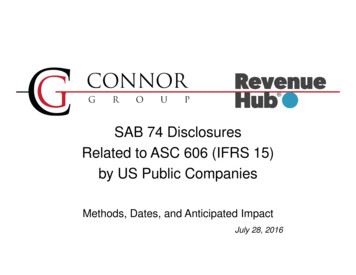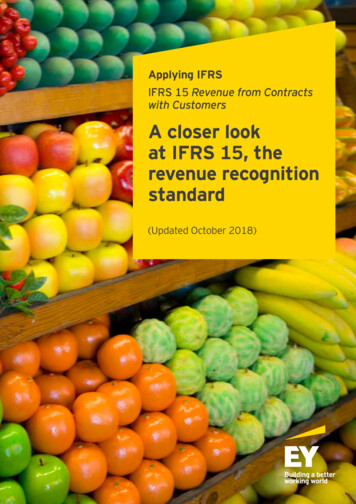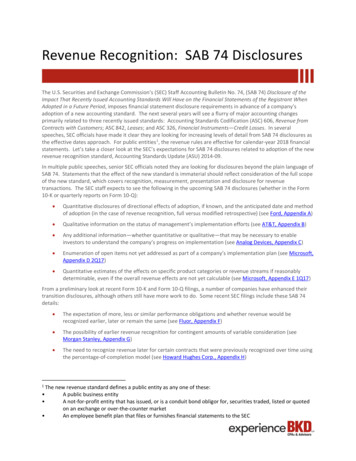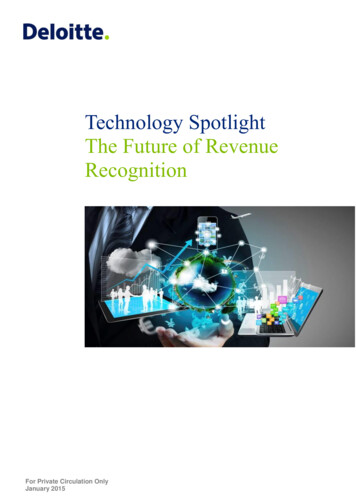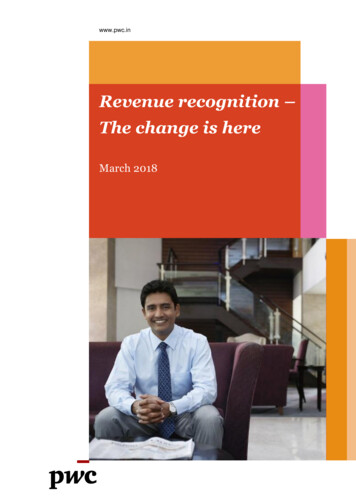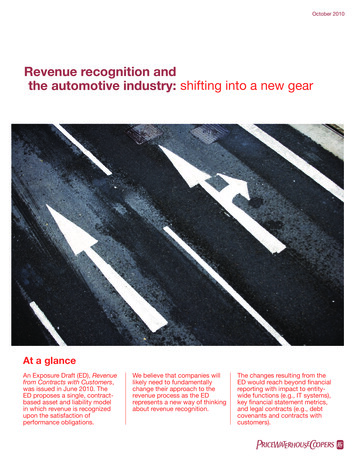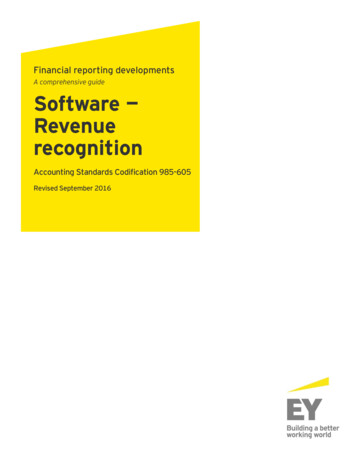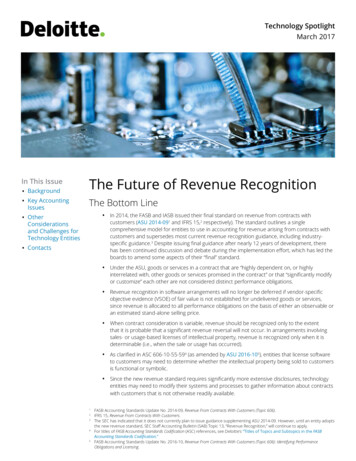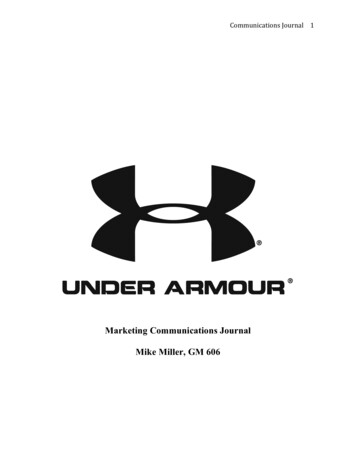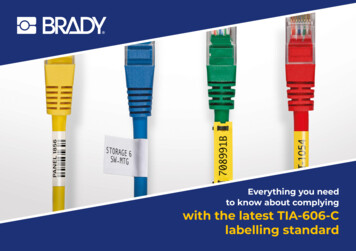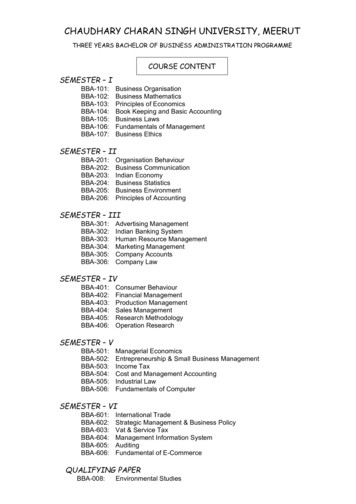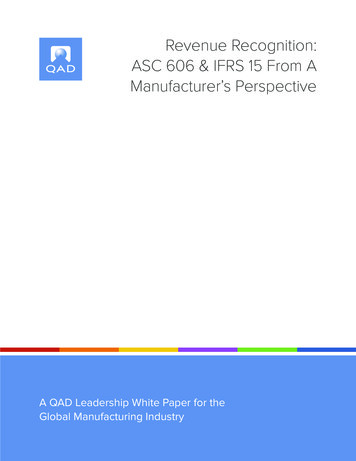
Transcription
Revenue Recognition:ASC 606 & IFRS 15 From AManufacturer’s PerspectiveA QAD Leadership White Paper for theGlobal Manufacturing Industry
CONTENTSSituation Overview 3Challenges 3Main provisions 3Why is the change being made? 4Who is impacted? 5When will this become a requirement? 5Solution Description 6What should you do? 6QAD Revenue Recognition Module 7Conclusion 9
REVENUE RECOGNITION:ASC 606 & IFRS 15 FROM A MANUFACTURER’S PERSPECTIVESITUATION OVERVIEW Providing a warranty with your productsNew Revenue recognition rules are coming intoeffect that will change the way some companiesrecognize revenue. Changes in these provisionsmay make revenue recognition more complicatedfor manufacturers. Changing prices for products during life of anorderThe Financial Accounting Standards Board (FASB)and the International Accounting Standards Board(I ASB) jointly drafted the standards embodiedin FASB Accounting Standards Codification(ASC) 606 and International Financial ReportingStandards (I FRS) 15 respectively. These standardshelp to clarify the principles for recognizingrevenue and can be applied consistentlyacross various transactions, industries, andcapital markets. Both are designed to improvefinancial reporting by creating common revenuerecognition guidance for U.S. GAAP and I FRS.The objective of the new rules is to establish theprinciples to report useful information to users offinancial statements about the nature, amount,timing, and uncertainty of revenue from contractswith customers.From a manufacturer’s perspective the followingare some examples of practices that may beimpacted: Goods and services on same order or that areinterrelated or cannot be used independently(for example required installation services for apiece of machinery).CHALLENGESMAIN PROVISIONSThe core principle is that revenue should berecognized in an amount and time period that isaligned with the expectation of the actual amountto be earned and when it is earned (ie goods orservices are delivered). Selling goods with volume discounts, rebates,interest-free credit, financing arrangements,discounted settlement terms or entitlements tofree goods Using Incoterms (International CommercialTerms) that transfer title to goods on receiptTo achieve this core principle, an entity shouldapply the following steps: Selling goods on a sale or return basisIdentify the contract(s)with a customerIdentify theperformanceobligationsin the contractDetermine thetransaction price3Allocate thetransaction priceto the performanceobligations inthe contractRecognizerevenue when(or as) the entitysatisfies aperformanceobligation
REVENUE RECOGNITION:ASC 606 & IFRS 15 FROM A MANUFACTURER’S PERSPECTIVE Allocate the transaction price to theperformance obligations in the contract There is a need for qualified accounting staffto be involved in applying judgment from theinception of contracts and through all stagesof delivery against such contracts to define,estimate and record the elements required toproperly determine the revenue recognition forthat contract.The new standard requires more extensivedisclosures in the financial statements, even if thenew rules mean for some companies that thereis no real change to the process of determiningrevenue recognition or the results themselves. Identify the contract(s) with a customer Identify contracts for revenue recognitionpurposes, which may not match with a singlesales order in the system. There may be casesw here what is delivered against two or moreorders may be considered as part of a singlecontract for revenue recognition purposes.Under ASC 606, a contract is defined as anagreement between two or more parties thatcreates enforceable rights and obligations where enforceability is “a matter of law.” Recognize revenue when (or as) theentity satisfies a performance obligation Management needs to determine when controlhas passed to the customer, and whether suchcontrol passes over time. The new standardcould mean that, in some cases, revenue hasto be recognized earlier than under previousstandards which would have required thatrevenue was only recognized at the end ofthe process when all of the economic risk hadtransferred to the customer. I n other cases,revenue recognition could be later than underprevious standards, if all the criteria in the newstandards are not met. Identify the performance obligations in thecontract - Define individual performanceobligations within the contract against whichrevenue may be allocated. I t could be that casethat several order lines are considered to bepart of the same performance obligation, w herethey are not considered to be distinct promisesto transfer goods or services.WHY IS THE CHANGE BEING MADE? Determine the transaction price - Determinethe impact of pricing, discounts, rebates andfree goods on the amount of revenue that canbe recognized at each stage of the contract.Revenue must be allocated to performanceobligations on the basis of standalone sellingprices, and revenue must be determined net ofvariable consideration. Variable considerationtakes into account the expected outcome offuture event, such as volume discounts, cashsettlement discount, etc.Revenue is a key measure used by stakeholdersto evaluate a company’s financial performanceand position. Previous revenue recognitionrequirements varied around the world and w erein need of improvement.U.S. GAAP guidelines contained both broadconcepts and specific requirements by industryor transaction type which sometimes resultedin different accounting for economically similartransactions. I n contrast, I FRS provided4
REVENUE RECOGNITION:ASC 606 & IFRS 15 FROM A MANUFACTURER’S PERSPECTIVElimited guidance making application difficult incomplex transactions and for multiple elementarrangements.From a manufacturing perspective, QADcustomers with the following characteristics aremore likely to be impacted:To address these issues, the FASB and the I ASBinitiated a joint project to clarify the principles forrecognizing revenue and to develop a commonrevenue standard for U.S. GAAP and I FRS thatwould: Food & Beverage / Consumer Packaged Goods:Sales promotions/variable pricing Automotive: Retroactive price changes, longterm contracts Life Sciences: High value equipment withrequired after sales service1. Remove inconsistencies and weaknesses inrevenue requirements Project related businessesCompanies that are Make to Stock (MTS) orAssemble to Order (ATO) are less likely to besignificantly impacted.2. Provide a more robust framework foraddressing revenue issues3. Improve comparability of revenue recognitionpractices across entities, industries,jurisdictions, and capital marketsWHEN WILL THIS BECOME A REQUIREMENT?4. Provide more useful information to usersof financial statements through improveddisclosure requirementsUnder ASC 606, public organizations should applythe new revenue standard to interim reportingperiods within annual reporting periods beginningafter December 15, 2017. Nonpublic organizationsshould apply the new revenue standard to interimreporting periods within annual reporting periodsbeginning after December 15, 2018. I FRS 15 iseffective for the first interim period within annualreporting periods beginning on or after January 1,2018, with early adoption permitted.5. Simplify the preparation of financial statementsby reducing the number of requirements towhich an entity must referThe result of these efforts is ASC 606 (Revenuefrom Contracts with Customers) and I FRS 15(Revenue from Contracts with Customers).WHO IS IMPACTED?Tw o methods exist for moving to the newstandard: full retrospective and simplifiedtransition (also known as modified retrospectiveapplication). Both methods seek to establishdual reporting for a period of time to allow forcomparisons and baselines.The new guidance on revenue recognition affectsany reporting organization (public and nonpublic)that either enters into contracts with customers totransfer goods or services or enters into contractsfor the transfer of nonfinancial assets unless thosecontracts are within the scope of other standards(for example, insurance contracts or leasecontracts; a comprehensive list is provided in ASC606-10).Under full retrospective adoption, companieswould track revenue using the existing andnew standard at least 1 year prior to when the5
REVENUE RECOGNITION:ASC 606 & IFRS 15 FROM A MANUFACTURER’S PERSPECTIVEHow QAD Can Helprequirements take effect. Under the SimplifiedTransition method, companies would start trackingaccording to the new rules when the requirementscome into effect and correct the first period forcontracts not yet completed while applying boththe new revenue standard and previous standardfor the first year of initial application.QAD Services can conduct a Revenue RecognitionQ-Scan assessment to help determine whatprocess and software options makes themost sense given the level of impact the newregulations have on your business and the versionof the software you are currently running.SOLUTION DESCRIPTIONFor customer currently running EnterpriseFinancials, the QAD Revenue Recognition Moduleis the suggested approach to evaluate. Moreinformation on the QAD Revenue Recognitionmodule is available in the next section.What should you do?With an effective date rapidly approachingpreparations should be made now. The impact ofthe new standard is likely to be different for eachcompany, and will depend on the industry in whichthey operate.Customers not running Enterprise Financialsshould consider an upgrade to EnterpriseFinancials to access the native functionality thatcan help address the new regulations.Rules are open to interpretation and Industryspecific interpretation of rules are still underdiscussion. Talk with your auditors for guidance onhow these rules apply to your company and workto develop a plan to address the new rules.QAD is developing a Revenue RecognitionHub that will allow SE and Pre SE customers toremain on their current release and leverage thefunctionality delivered in the Revenue RecognitionModule outlined above. With additional services,the hub can be extended to cover 3rd party ERPsystems.Companies need to consider how the newrevenue recognition will affect other departmentsthan the Finance department, including possiblechanges to the way that goods and services aresold, and the way in which sales staff and otheremployees are remunerated.Other options exist including implementingmanual process (spreadsheets, manual journalentries, use of extra entities for dual reportingperiod), Customizations to reduce amount ofmanual work and potential for errors to meetcompliance requirements and 3rd party solutionswith associated integration.Enhancements or customizations to your varioussoftware applications may be required in orderto support any process changes that you need tomake in light of the new regulations.If you are impacted by these new regulations QADcan help.The Revenue Recognition Q-Scan assessment isdesigned to assist you in the evaluation of theseoptions.6
REVENUE RECOGNITION:ASC 606 & IFRS 15 FROM A MANUFACTURER’S PERSPECTIVEQAD REVENUE RECOGNITION MODULEone integrated enterprise system for revenuerecognition, and the ability to report both underthe new rules and without them.QAD is developing a Revenue Recognitionmodule. The module is being developed for QADFinancials 2017 and will also run on any priorversion of Enterprise Edition.The solution delivers the software components todefine and store rules, link the rules to customersand performance obligations, define daybooks,and create associated Gl and Sub-ledgertransactions.Enterprise Financials was selected as a targetedition for its support of Dual Books which is animportant component of the solution.The following QAD Process flow maps the stepsoutlined in the standards set forth by FASB andthe I ASB.The Revenue Recognition module makes it easierfor Manufacturers to meet the requirementsassociated with the new rules. It provides forgreater visibility, real time reporting, an audit trail,7
REVENUE RECOGNITION:ASC 606 & IFRS 15 FROM A MANUFACTURER’S PERSPECTIVE Revenue Contracts - Revenue contractsare created within the Revenue Recognitionmodule. Each contract can link to sales orders,operational and financial invoice records.One contract can contain several orders.One order/invoice can be split between twoor more revenue contracts. The associatedcontract documents and recognition calculationworksheets can be stored in the system asattachments.Key components of the solution are outlinedbelow.Rule Maintenance - The module provides ameans for rule maintenance and prov ides predefined rule types including: Acceptance Payment Number of days from shipment/invoice Percentage of completion Periodic recognition, e.g. for servicesBeyond the pre-defined rule types, customizationoptions are available. By default, rules link tocustomer then to performance obligations. Revenue Recognition Sub-Ledger - The subledger stores detailed revenue recognitiontransactions at performance obligation level.It provides a full audit trail of movements ondeferred revenue accounts and allow s for “asof date” reporting. Daybooks - Revenue Recognition in stored ina separate sub-ledger and requires a separatedaybook type. Multiple daybooks of this typeare allow ed and provide for posting to officialor management layers. Daybooks can also beconfigured for auto posting per entity.8
REVENUE RECOGNITION:ASC 606 & IFRS 15 FROM A MANUFACTURER’S PERSPECTIVECONCLUSIONQAD is developing a Revenue Recognitionmodule for QAD Financials 2017 that will also runon any prior version of Enterprise Edition. TheRevenue Recognition module makes it easierfor Manufacturers to meet the requirementsassociated with the new rules. I t provides forgreater visibility, real time reporting, an audit trail,one integrated enterprise system for revenuerecognition, and the ability to report both underthe new rules and without them.New Revenue recognition rules are coming intoeffect that will change the way some companiesrecognize revenue. Changes in these provisionsmay make revenue recognition more complicatedfor manufacturers.From a manufacturing perspective, QADcustomers with the following characteristics aremore likely to be impacted: Automotive: Retroactive price changes, longterm contractsCustomers not running Enterprise Financialsshould consider an upgrade to EnterpriseFinancials to access the native functionalityprovided by the Revenue Recognition module. Life Sciences: High value equipment withrequired after sales serviceIf you are unable to move to Enterprise Financialsother options exist. Food & Beverage / Consumer Packaged Goods:Sales promotions/variable pricing Project related businessesQAD is developing a Revenue RecognitionHub that will allow SE and Pre SE customers toremain on their current release and leverage thefunctionality delivered in the Revenue RecognitionModule outlined above.Under ASC 606, Public organizations should applythe new revenue standard to interim reportingperiods within annual reporting periods beginningafter December 15, 2017. Nonpublic organizationsshould apply the new revenue standard to interimreporting periods within annual reporting periodsbeginning after December 15, 2018. I FRS 15 iseffective for the first interim period within annualreporting periods beginning on or after January 1,2018, with early adoption permitted.QAD Services can conduct a Revenue RecognitionQ-Scan assessment to help determine whatprocess and software options makes themost sense given the level of impact the newregulations have on your business and the versionof the software you are currently running.Rules are open to interpretation and Industryspecific interpretation of rules are still underdiscussion. Talk with your auditors for guidance onhow these rules apply to your company and workto develop a plan to address the new rules.For more information, please contact QAD atrevrec@qad.com9
QAD Inc.100 Innovation PlaceSanta Barbara, CA93108 USATel: 1 805 566 6100www.qad.com
REVENUE RECOGNITION: ASC 606 & IFRS 15 FROM A MANUFACTURER’S PERSPECTIVE 4 The new standard requires more extensive disclosures in the financial statements, even if the new rules mean for some companies that there is no real change to the process of determining revenue recognition or the results themselves.File Size: 460KB
